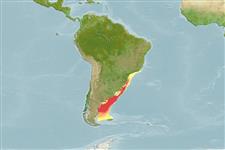Common names from other countries
Environment: milieu / climate zone / depth range / distribution range
पारिस्थितिकी
समुद्री; खारा बेनथोपिलाजिक; गहराई सीमा 15 - 82 m (Ref. 127778). Subtropical; 13°S - 53°S, 67°W - 40°W
Southwest Atlantic: Brazil, Argentina, and Uruguay.
Length at first maturity / आकार / वज़न / Age
Maturity: Lm 29.0 range ? - ? cm
Max length : 60.0 cm TL पुल्लिंग / अलिंग; (Ref. 7392)
पृष्ठीय रीढ़ (सम्पूर्ण): 13; पृष्ठीय सौफट रेज़ (सम्पूर्ण): 15; गुदा कांटा 3; ऐनल सौफट रेज़: 8
Found on the continental shelf in colder waters. Utilized to some degree for human consumption.
Pereiro, S. and A. Vásquez, 1988. Peces marinos III. p. 65-94. In G.B. Cabal, B. Marcheti (eds.) Fauna Argentina: Peces. Centro Editor de América Latina S.A., Junin, Buenos Aires, Brazil, 102 p. (Ref. 7392)
IUCN Red List Status (Ref. 130435)
CITES (Ref. 128078)
Not Evaluated
Threat to humans
Harmless
Human uses
मात्स्यिकी: व्यापारिक
अधिक जानकारी
सहयोगीयोतस्वीरेStamps, Coins Misc.ध्वनिसिगुयटिरारफ्तारतैरने के प्रकारगिल क्षेत्रOtolithsदिमागदृष्टि
साधन
Special reports
Download XML
इंटरनेट स्रोत
Estimates based on models
Preferred temperature (Ref.
115969): 4.5 - 16.9, mean 8.1 (based on 170 cells).
Phylogenetic diversity index (Ref.
82804): PD
50 = 0.5005 [Uniqueness, from 0.5 = low to 2.0 = high].
Trophic level (Ref.
69278): 4.0 ±0.71 se; based on food items.
लौटाव (Ref.
120179): माध्यम, न्यूनतम जनसंख्या दुगनी होने का समय 1.4 - 4.4 वर्ष। (Assuming tm=2-4).
Fishing Vulnerability (Ref.
59153): Moderate vulnerability (44 of 100).
Climate Vulnerability (Ref.
125649): Very high vulnerability (86 of 100).
